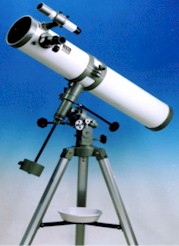 |
 |
 |
 |
 |
||
| Technology -> Telescopes |
|
Telescopes: Telescopes are instruments designed for the observation of distant objects and the collection of electromagnetic radiation.
The term "telescope" usually refers to the most common type of telescope called an "optical telescope." There are also telescopes that collect data from other parts of the electromagnetic spectrum. Optical telescopes gather and focus light primarily from the visible part of the electromagnetic spectrum (although some work in the infrared and ultraviolet). They can gather many times the amount of light than your eye can. Optical telescopes have main lenses in them that collect light from objects in the sky. These lenses focus the light, by either bending it (refracting telescopes) or reflecting it (reflector telescopes) to form an image. Optical telescopes increase the apparent angular size of distant objects, as well as their apparent brightness. Telescopes work by employing one or more curved optical elements - lenses or mirrors - to gather light or other electromagnetic radiation and bring that light or radiation to a focus, where the image can be observed, photographed or studied. Radio telescopes send out and gather electromagnetic radiation from the microwave and radio part of the electromagnetic spectrum. These telescopes are directional radio antennae that often have a parabolic shape. The dishes are sometimes constructed of a conductive wire mesh whose openings are smaller than the wavelength being observed. See radio waves for more details. X-ray and gamma-ray telescopes have a problem because these rays go through most metals and glasses. Some x-ray telescopes use ring-shaped "glancing" mirrors, made of heavy metals, that reflect the rays just a few degrees. The mirrors are usually a section of a rotated parabola. Gamma-ray telescopes give up on focusing entirely, and use coded aperture masks; the pattern of shadows the mask creates can be reconstructed to form an image. These types of telescopes are usually on Earth-orbiting satellites or high-flying balloons, since the Earth's atmosphere is opaque to this part of the electromagnetic spectrum. See gamma-rays and x-rays for more details. Additional Links:
|
|
 As discussed in the section called "
As discussed in the section called "